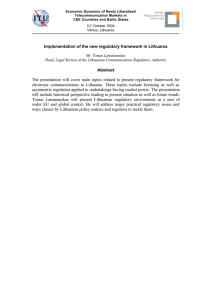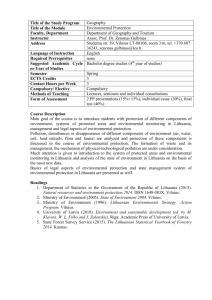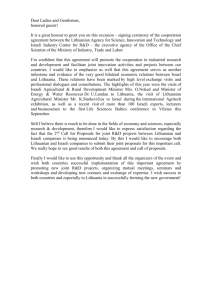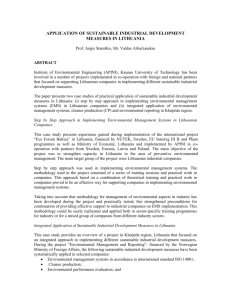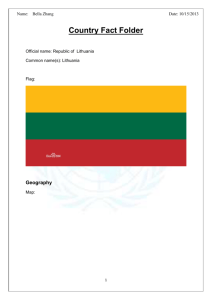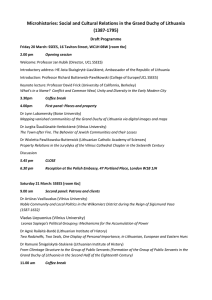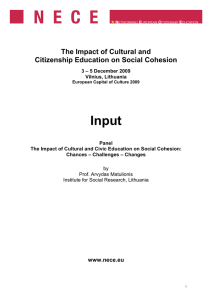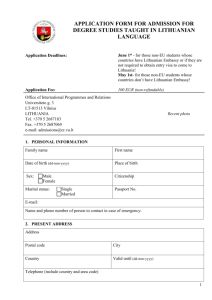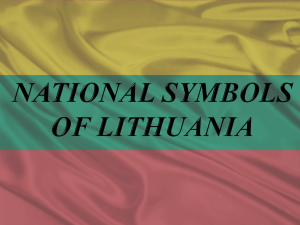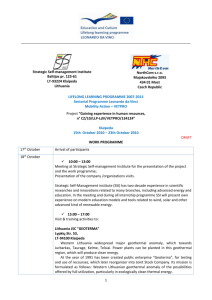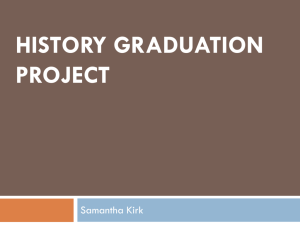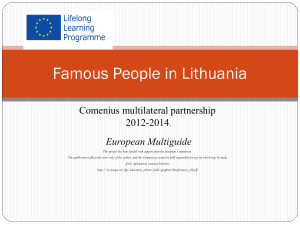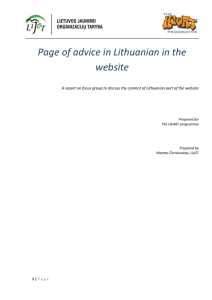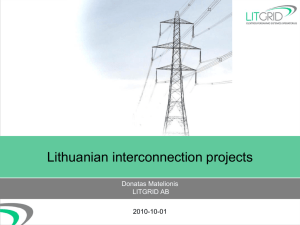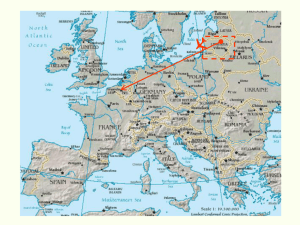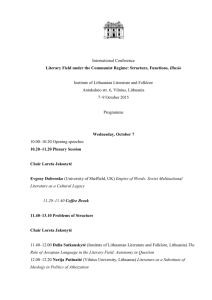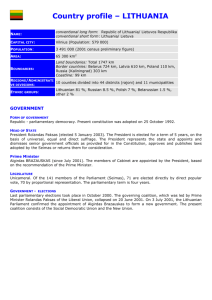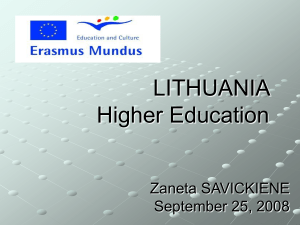rather cultural
advertisement
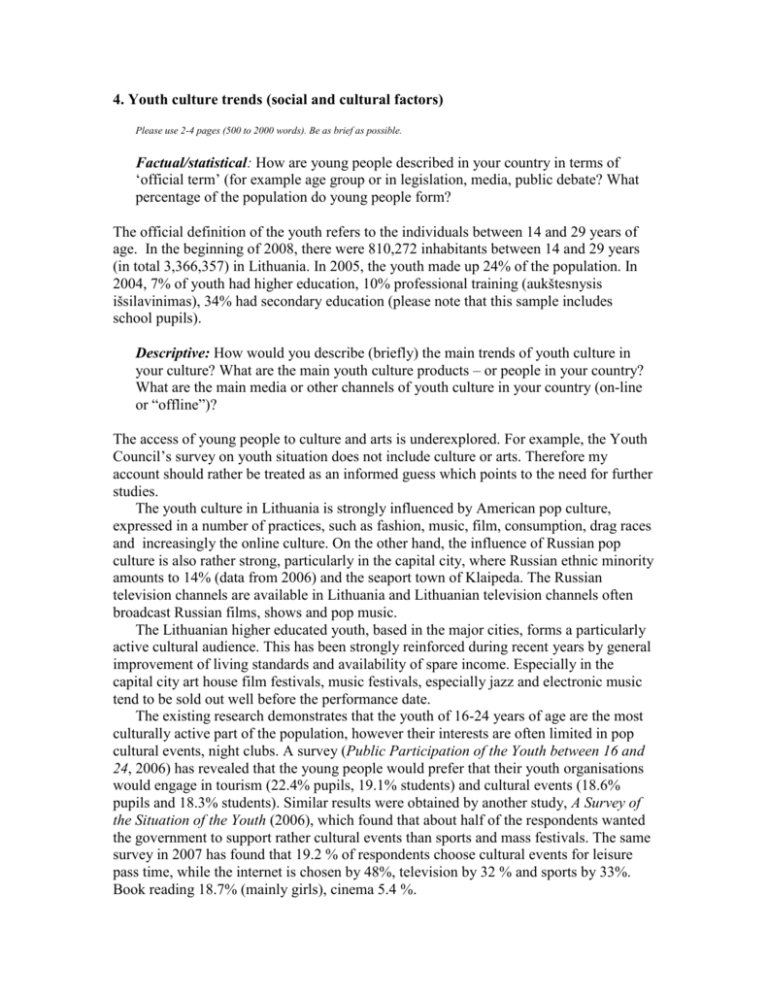
4. Youth culture trends (social and cultural factors) Please use 2-4 pages (500 to 2000 words). Be as brief as possible. Factual/statistical: How are young people described in your country in terms of ‘official term’ (for example age group or in legislation, media, public debate? What percentage of the population do young people form? The official definition of the youth refers to the individuals between 14 and 29 years of age. In the beginning of 2008, there were 810,272 inhabitants between 14 and 29 years (in total 3,366,357) in Lithuania. In 2005, the youth made up 24% of the population. In 2004, 7% of youth had higher education, 10% professional training (aukštesnysis išsilavinimas), 34% had secondary education (please note that this sample includes school pupils). Descriptive: How would you describe (briefly) the main trends of youth culture in your culture? What are the main youth culture products – or people in your country? What are the main media or other channels of youth culture in your country (on-line or “offline”)? The access of young people to culture and arts is underexplored. For example, the Youth Council’s survey on youth situation does not include culture or arts. Therefore my account should rather be treated as an informed guess which points to the need for further studies. The youth culture in Lithuania is strongly influenced by American pop culture, expressed in a number of practices, such as fashion, music, film, consumption, drag races and increasingly the online culture. On the other hand, the influence of Russian pop culture is also rather strong, particularly in the capital city, where Russian ethnic minority amounts to 14% (data from 2006) and the seaport town of Klaipeda. The Russian television channels are available in Lithuania and Lithuanian television channels often broadcast Russian films, shows and pop music. The Lithuanian higher educated youth, based in the major cities, forms a particularly active cultural audience. This has been strongly reinforced during recent years by general improvement of living standards and availability of spare income. Especially in the capital city art house film festivals, music festivals, especially jazz and electronic music tend to be sold out well before the performance date. The existing research demonstrates that the youth of 16-24 years of age are the most culturally active part of the population, however their interests are often limited in pop cultural events, night clubs. A survey (Public Participation of the Youth between 16 and 24, 2006) has revealed that the young people would prefer that their youth organisations would engage in tourism (22.4% pupils, 19.1% students) and cultural events (18.6% pupils and 18.3% students). Similar results were obtained by another study, A Survey of the Situation of the Youth (2006), which found that about half of the respondents wanted the government to support rather cultural events than sports and mass festivals. The same survey in 2007 has found that 19.2 % of respondents choose cultural events for leisure pass time, while the internet is chosen by 48%, television by 32 % and sports by 33%. Book reading 18.7% (mainly girls), cinema 5.4 %. On the other hand majority of Lithuanian youth have limited income to be able to afford all desired music, film and attend all the events. There is no hard data, but it can be safely estimated that the most of film and music consumed by Lithuanian youth is acquired through pirate file-share websites or bought on the black market. There is no data about the cultural consumption of young people in the rural areas. However, it can be estimated that the film, computer game and music production downloaded from pirate websites forms a substantial share of their cultural experiences. As mentioned above, the income of youth is rather limited, even more so of the young people who live in rural areas. The public transport is not well developed in Lithuania and it is difficult for countryside youth to travel to the major cities. Even though illegal downloading is classified as a criminal activity in Lithuania, it can be argued that the pirate sources are often the key sources to access culture for young people in rural, but also urban areas of Lithuania. Finally, it has to be noticed that there is no big public discussion about illegal downloading in the country. The main media channels are those which specialise in music and reality TV programmes (for example MTV Lithuania). In the press the most popular are the magazines Panele and Pravda. The main site for the interaction of young people is the Internet, mainly online forums and social networking tools, such as Frype (www.frype.lt). At the moment of writing blogging has not yet gained a particularly popularity in Lithuania. According to the survey (General Computer Literacy Survey, 2008) in 2008 the young people between 15 and 34 years of age evaluate their ability to use computer as good. The youth between 15 and 24 years old and those based in the major cities, like Vilnius and Kaunas most likely to use internet in palm or mobile phones. They are also most likely to use IT for leisure. Lithuania has inherited a rather well developed network of arts schools and arts educational circles from the Soviet past. The arts are integrated in the school curriculum. In 2006 it was found that almost 50% of children in the secondary schools participate in artistic education circles. However, the existing art schools are described as being “too academic, dedicated to professional training”. Lithuanian museums are active in attracting young people. In 2006 the museums arranged around 7,580 educational events per year in which ca 164,000 of school pupils participate. Cultural education is practices by the Philharmonic society and theatres (2006). In 2007, ca 800,000 children visited cultural events in the art galleries, museums, theatres, concert halls. Visibility: Do you have an impression that young people are taken into consideration in your country, or that they have enough visibility? Are there any issues of youth culture that have been subjects of public debate recently? Please, support your statements with facts/arguments. During recent years young people became increasingly visible in the media, where they tend to be framed both as a problem and an asset in relation to migration. This became especially salient after 2003 when Lithuania has joined the EU. According to Eurostat (2009) data, Lithuania leads in terms of emigration in the EU. Since 2000, the population has shrunk by 3.9%. As a result brain drain is considered to be an important problem and the government has initiated special programmes to address this issue. However, the regular surveys conducted by the Council of Youth Affairs revealed that only 37% of Lithuanian youth between 14 and 29 thought that the situation was improving in the country (2005-2006). About 70% of youth wanted to go abroad at least for a while, even though 80% of them described themselves as happy. In 2007, 78% of young people had friends or family members who worked abroad and about 67% admitted that for various reasons they would consider emigrating to work abroad. 11.5% think that during next 5 years they will emigrate abroad. Another important aspect of framing young people as a problem in the public sphere is human trafficking, especially of young women. Many public campaigns have been conducted in the public sphere to counteract this trend. The issues of the culture of publicly tolerated sexism are being increasingly raised in the media. However, the research shows that women’s employment is generally very high in Lithuania (Motiejunaite 2008). Other aspects of youth visibility concern drug addiction and other crime, especially dangerous driving. It is indeed rather striking that since 1990 there have been hardly are any cases of generational-cultural clashes in the public sphere. It can be hypothesised that the engagement in the cyberspace, online computer games will cause more generational controversy in future. Issues sometimes are raised whether to allow children to play computer games in school. On the other hand, young people who are high achievers in “high culture” are more visible in media than young people who are engaged in subcultures. For example, an internationally acclaimed young opera singer Liora Grodnikaite has been often featured on television programmes and lifestyle magazines. But the youth subcultures, especially the new and increasingly popular ones such as Goths and Emos are arguably considerably less known, especially among non-urban, older part of the population. Finally, the gay and lesbian culture could be seen as the one causing more controversy and it also tends to be problematised in relation to young people, especially children. Surveys reveal that Lithuanians exhibit a high social distance from Roma and homosexuals. The Lithuanian Gay League has been publicly complaining that Vilnius the European Capital of Culture did not include any cultural events which would relate to gay culture. The Gay Parade has been discussed in the media for several years now and any suggestions to organise a Gay Parade in Vilnius attracted many xenophobic comments from Internet commentators. Obstacles: What is your interpretation of the central challenges for young people that keep young people from participating in culture? Probably unlike the Western European countries which shows that it is rather education and not income that limits arts attendance, Lithuania low income is a significant factor that limits cultural consumption. For example, an average household spending in 2007 was 657 Lita per family member per month. For leisure and culture was spent 41 Lita per family member per month. This hardly buys one music CD or two cinema tickets. Unemployment is high among the youth. According to the data from 2004, the youth unemployment is higher than that of general population (in Vilnius by 2.8% and in Alytus by 9.4%). Since 1996, the government runs a financial programme which supports children summer recreation programmes, but it is oriented to those children who need welfare support and therefore does not ensure equal opportunities (In 2003 2.9 million Lita were allocated for this scheme). In the end of 2008 the Lithuanian government increased VAT on print materials. This is going to increase the price of books and press by 14%. Finally, difficulty of physical access should be mentioned. The majority of cultural events are concentrated in the capital and other major cities, such as Kaunas and Klaipeda.
